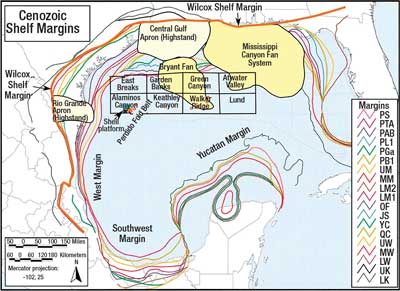What's new in exploration
Paradigm lost in GOM's deepwater Wilcox play
Deepwater Wilcox play in the Gulf of Mexico: Paradigm lost. A capacity crowd filled the Houston Petroleum Club in late November 2006, to hear a presentation on the trend of oil discoveries in the Lower Tertiary Wilcox Group of the deepwater Gulf of Mexico. Earlier in the year, Chevron had announced flowrates of 6,000 bopd from its Jack 2 appraisal well 200 mi offshore in the Walker Ridge OCS protraction area. At about the same time, Shell announced plans to build a platform to develop Wilcox discoveries in the Perdido Fold Belt region of the Alaminos Canyon OCS area. To date, at least 19 exploratory wells have penetrated a thick, high-quality, Lower Tertiary sandstone reservoir interval in the Alaminos Canyon, Keathley Canyon and Walker Ridge OCS areas. Twelve of these tests have discovered oil and gas, with reserve estimates for the deepwater Wilcox trend ranging from 3 to 15 billion boe recoverable. The story told by Larry Zarra and his Chevron colleagues at the meeting was that the deepwater Wilcox fits neatly into the existing paradigm for the GOM Cenozoic. Wilcox reservoirs of the deep OCS represent turbidite and submarine fan successions deposited down-dip from the well-accepted Wilcox deltaic centers, shelf margin and upper slope deposits of Texas and Louisiana onshore regions. The Gulf Coast paradigm assumes that the GOM has been relatively stable and uniform since the basin and seaway opened in the Jurassic. The paradigm does, however, allow for high-frequency sea-level fluctuations that produced pronounced basinward and landward shifts in depositional centers. These base-level cycles are commonly invoked to explain slope and basin-floor reservoirs that extend beyond their respective shelf margins into deepwater environments of deposition. This aspect of the model, however, is not generally applied to the Paleogene, because the Paleocene and Eocene epochs were hot-house periods of Earth’s history without polar ice caps and, hence, without an obvious mechanism to produce eustatic sea-level change. The presence and character of Wilcox sandstone reservoirs in the deep Gulf of Mexico signal an end to the current Gulf Coast paradigm and challenge explorationists to develop a new model for depositional controls and dynamics for the Tertiary Gulf of Mexico basin. The fundamental problem is that no other Tertiary depositional system delivered sand as far from the shelf margin as is required for the Wilcox, much less 200 mi from the base of the continental slope.
Defenders of the paradigm point out that modern deepwater systems are capable of transporting sand hundreds of miles onto the basin floor from the base of the slope. This may be true for thin, channelized sand bodies but not for thick, amalgamated sandstones that cover thousands of square miles. Where sand channels are found on the abyssal plain, they are typically underlain and surrounded by tremendous volumes of shale and silt. In fact, turbidite systems require high shale volumes to prevent drop-out of the sand fraction near the base of the continental slope. Where are the necessary shale volumes in the Wilcox? The figure shows the extent of Pleistocene (Sangamonian) submarine sediment accumulations restored to Wilcox shelf margins. The amount of sediment delivered to the GOM in the Pleistocene was anomalous by any measure but especially with respect to the Paleocene-Eocene. Pleistocene sediment supply involved full capture of the North American continental drainage system by the Mississippi River, which was a relatively minor river for the Wilcox. The upper Mississippi, Ohio and Missouri rivers drained north to the Arctic until the Pleistocene. The Pleistocene epoch included widespread glacial erosion of the craton and unprecedented volumes of meltwater to flush sediment into the GOM; there was no corresponding glacial event for the Wilcox. Despite the inequality of the comparison, not even the Pleistocene system could have delivered significant sediment to the Perdido Fold Belt when restored to Wilcox shorelines and shelf margins. Only during the Pleistocene lowstand would some distal sediment have been provided to the Walker Ridge area by the Wilcox equivalents of the Pleistocene Mississippi and Bryant fans. The composition of those fan systems is overwhelmingly mud and silt, with sands limited to thin (< 1 m), isolated beds, and not the thick amalgamated sandstones found in the Wilcox. A paradigm provides adequate explanations for many scientific observations but generally fails to explain all the facts. Thomas Kuhn in his brilliant essay, The Structure of Scientific Revolutions, described how, once a paradigm is entrenched, questions and suggestions about alternative explanations are strongly resisted by the scientific community. The discovery of thick, amalgamated, and widely distributed sandstone reservoirs in the deepwater Wilcox represents an anomaly without precedent in the depositional systems of the Gulf Coast basin, and cannot be adequately understood using existing deepwater models. A new paradigm will emerge yielding great opportunities for exploration. Arthur Berman is a geological consultant specializing in petroleum geology, seismic interpretation and database design and management. He has over 20 years working for major oil companies and was editor of the Houston Geological Society Bulletin. He earned an MS in geology from the Colorado School of Mines.
|
|||||||||||
- Prices and governmental policies combine to stymie Canadian upstream growth (February 2024)
- U.S. producing gas wells increase despite low prices (February 2024)
- U.S. drilling: More of the same expected (February 2024)
- U.S. oil and natural gas production hits record highs (February 2024)
- Quantum computing and subsurface prediction (January 2024)
- U.S. upstream muddles along, with an eye toward 2024 (September 2023)
- Applying ultra-deep LWD resistivity technology successfully in a SAGD operation (May 2019)
- Adoption of wireless intelligent completions advances (May 2019)
- Majors double down as takeaway crunch eases (April 2019)
- What’s new in well logging and formation evaluation (April 2019)
- Qualification of a 20,000-psi subsea BOP: A collaborative approach (February 2019)
- ConocoPhillips’ Greg Leveille sees rapid trajectory of technical advancement continuing (February 2019)





